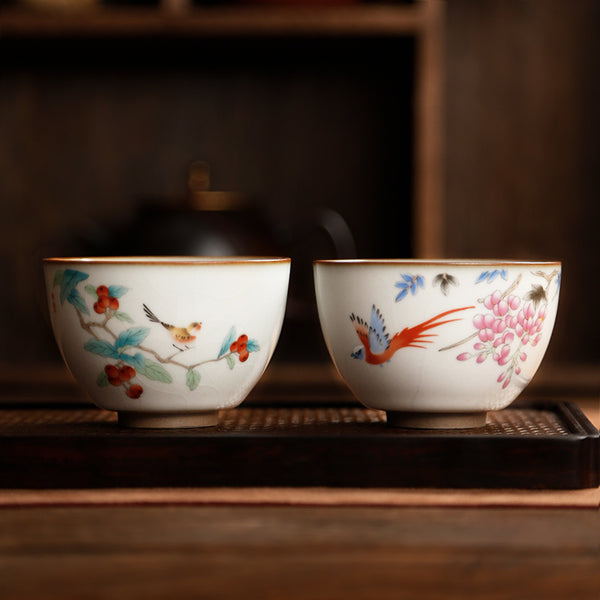
The “Mirror Tile” Shaped Teapot: A Hidden Gem in Chinese Teaware
Share
The “Mirror Tile” Shaped Teapot: A Hidden Gem in Chinese Teaware
In the rich and diverse world of Chinese teapots, each form carries not only practical advantages but also deep cultural and aesthetic meanings. We will spend some time to unlock the behind stories of some of these famous shapes.

Among the less commonly known yet highly respected styles is the "Mirror Tile" teapot (镜瓦壶, Jing Wa Hu). Elegant, understated, and geometrically refined, the Mirror Tile teapot stands out for its architectural beauty and historical associations.
Origins and Name
The name "Mirror Tile" refers to the teapot’s resemblance to the flat, rectangular roof tiles used in traditional Chinese architecture — specifically, the glazed tiles that adorned the roofs of palaces, temples, and wealthy homes. These tiles, sometimes likened to bronze mirrors in their shape and luster, were a symbol of refinement and classical taste.
The teapot shape inspired by these tiles is typically rectangular or slightly arched, with clean lines, sharp edges, and a balanced symmetry that mimics the precision of architectural elements. It reflects the literati values of order, modesty, and intellect, and is often associated with the scholar’s studio — a place of contemplation, art, and refined taste.
Design Characteristics
The Mirror Tile teapot is notable for several distinct features:
-
Flat or slightly curved body: Its main panels resemble tiles — broad, flat surfaces that are either straight-edged or subtly domed.
-
Squared or rectangular profile: Unlike the more common round or pear-shaped teapots, the Mirror Tile has angular geometry that emphasizes craftsmanship and precision.
-
Straight spout and handle: These components are usually aligned to maintain the teapot’s linear symmetry.
-
Flush lid: The lid often sits nearly flush with the top of the teapot, reinforcing its low-profile elegance.
Despite its structured appearance, a well-made Mirror Tile teapot has a warm, tactile appeal. It invites touch, inspection, and admiration for the skill involved in its making.
Craftsmanship and Clay
Creating a Mirror Tile teapot requires exceptional technical skill. Unlike more rounded forms, which allow for minor adjustments during shaping, the Mirror Tile’s flat surfaces and sharp corners leave little room for error. Artisans must carefully balance the proportions and angles to ensure that the teapot does not warp during firing.

Traditionally, these teapots are made from Yixing Zisha clay — especially the yellow clay or red clay varieties. The natural texture and subtle color variations of Zisha clay complement the clean lines of the teapot, lending it an understated but striking presence.
Functionality and Tea Brewing
While the Mirror Tile teapot is admired for its form, it is also a fully functional brewing vessel. Its flat bottom and broad shape make it well-suited for teas that benefit from a wide leaf spread, such as large-leaf pu-erh or loosely rolled oolongs.
However, its angular structure can cause water to cool more quickly than in more compact teapots, so it is not always the best choice for high-temperature teas like some green teas. Nonetheless, many tea enthusiasts appreciate the way this shape emphasizes clarity in both form and flavour.
Cultural and Aesthetic Significance
More than just a brewing tool, the Mirror Tile teapot is often considered a work of art. Its architectural form is a visual homage to classical Chinese aesthetics: order, balance, and harmony between human craft and natural material.
In literati circles, this teapot shape is often displayed alongside calligraphy, scrolls, and scholarly objects. It represents not just taste, but a worldview — one that values discipline, quiet reflection, and a deep connection to tradition.
Conclusion
The Mirror Tile teapot may not be as widely recognized as round-bodied or pumpkin-shaped teapots, but for collectors, scholars, and devoted tea drinkers, it offers something unique. Its combination of geometric elegance, technical difficulty, and cultural resonance makes it a shining example of Chinese teapot artistry — like the mirror tiles that inspired it, reflecting both tradition and refined taste.
Grab a mirror tiled teapot for your teapot collection today at
https://www.tpotsoriental.co.uk/products/playing-fishing-cermaic-pot?utm_source=copyToPasteBoard&utm_medium=product-links&utm_content=web

